Over time, the intensity in football matches has greatly increased, with the result that today’s players have less and less time and space to express themselves. All this is happening at a greater speed, and you have to be able to take decisions and act in a very limited time. Because of their higher positions on the pitch, attacking players have the responsibility to make the difference in very tight spaces and faced with a high density of opposing players. This is the case for modern wingers, whose position is a little more axial following the offensive emergence of full-backs. Modern wingers are moving away from their sides to give space to their full-backs, and are positioning themselves in the half-spaces, in order to provide solutions to penetrate the opponent’s block.
There are more and more inverted wingers, who play on the side of their weak foot, and therefore have more ease cutting inside with the game in front of them. They thus enjoy more freedom in their positioning, but also in their role with the ball, where they are expected to bring creativity. In this data analysis, we will focus on the young wingers in Ligue 1, who are the most creative in possession of the ball.
What is a creative player?
A creative player is above all a player who is very versatile in what he can do with the ball. This versatility not only makes him unpredictable for opposing defenders but also allows him to find solutions to help his team advance towards the opposing goal. He is, therefore, a player who possesses a large skill set and combines it with quick decision-making.
The creative player must also be able to adapt to the different problems imposed by the opposing defence and make the best decision, which will allow his team to get opportunities to score. He can either create these opportunities for a partner through creative passing or for himself through running or dribbling. Vision, understanding of space and flair are qualities he needs to be effective.
Analysis conditions
For this data analysis, I focused on the young wingers, who play in Ligue 1. Here are the criteria for the analysis :
– 23 years old or younger
– At least 500 minutes played in Ligue 1
– Play as a winger or have played there many times (Jordan Ikoné has for example played as an advanced midfielder but has also played several times on the wings)
Legends will be available at the top left of each graph to add context and detail to the data being studied.
Creative passes
For the first graph, we will look at two types of passes found in the data provided by Wyscout: the smart pass and the through pass. These two stats allow us to judge the ability of players to be creative and efficient in creating or finding space for their partners.
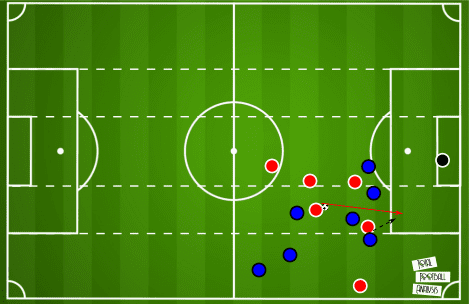
According to Wyscout, a through pass is “a pass played into space behind the defensive line for a teammate to contest. “In the image above, there is an example of a through pass on a counter-attack for the red team. Despite the defensive withdrawal of the blue team, the red player in possession of the ball manages to make a through pass into the right half-space and allows his partner to be in one-on-one with the opposing goalkeeper. This pass is made behind the blue team’s last defensive line.

According to Wyscout, a smart pass is a “creative and penetrative pass that attempts to break the opposition’s defensive lines to gain a significant advantage in attack.” The image above is a reproduction of real game action during the match between PSG and Reims in the cup. Leandro Paredes is in possession of the ball and faces the low and compact Reims block. He sees one of his teammates move between the opposing lines, and makes a superb pass, which breaks the lines. This pass allows his partner to be in a very interesting position to advance towards the opponent’s goal.
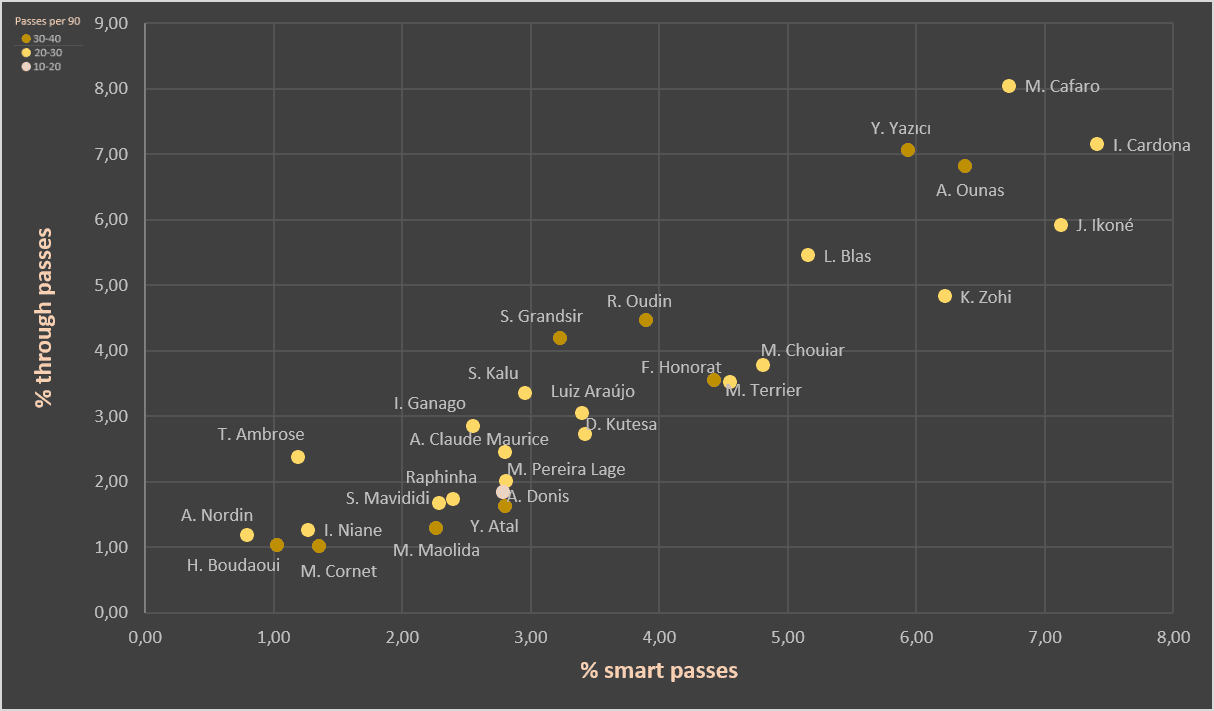
In the graph above, we look at the % of through passes and % of smart passes for young Ligue 1 wingers. The % is done in order to hide the differences in balls touched between players, and thus judge the % of smart passes per 90 and the % of through passes per 90 made by a player, compared to his total number of passes per 90.
Mathieu Cafaro is impressive in this area, with 6.72% smart passes and 8.05% through passes. This shows that he is regularly able to find solutions in the opponent’s block and that he is able to put his partners in goal conditions. The same goes for Irvin Cardona, with 7.15% of through passes and 7.41% of smart passes. Note that the Brest player is mainly a goalscorer, but he also played on the wing this season. In addition to his qualities of finisher that we’ll see later, he is also an interesting asset in terms of creation.
The two Lille players Yusuf Yazıcı and Ikoné are also very good in this area, and far ahead from other young Ligue 1 wingers. Ikoné displays 7.13% of smart passes per 90 and the Turkish player displays 7.06% of through passes. The same goes for Adam Ounas of Nice, Kévin Zohi of Strasbourg and Ludovic Blas of Nantes.
Intention to play forward
The player’s intentions and especially his willingness to play forward is an interesting component to study in order to judge a player’s creativity. It shows his ability to find solutions despite the difficulties proposed by the opposing block. In addition to his forward intentions, the creative player must be able to create real scoring opportunities for his team. That is why the following graph, in addition to showing the % of forward passes made by a player, shows the number of key passes per 90. According to fbref.com, a key pass is “a pass that directly leads to a shot”. Three players stand out quite clearly in this area.
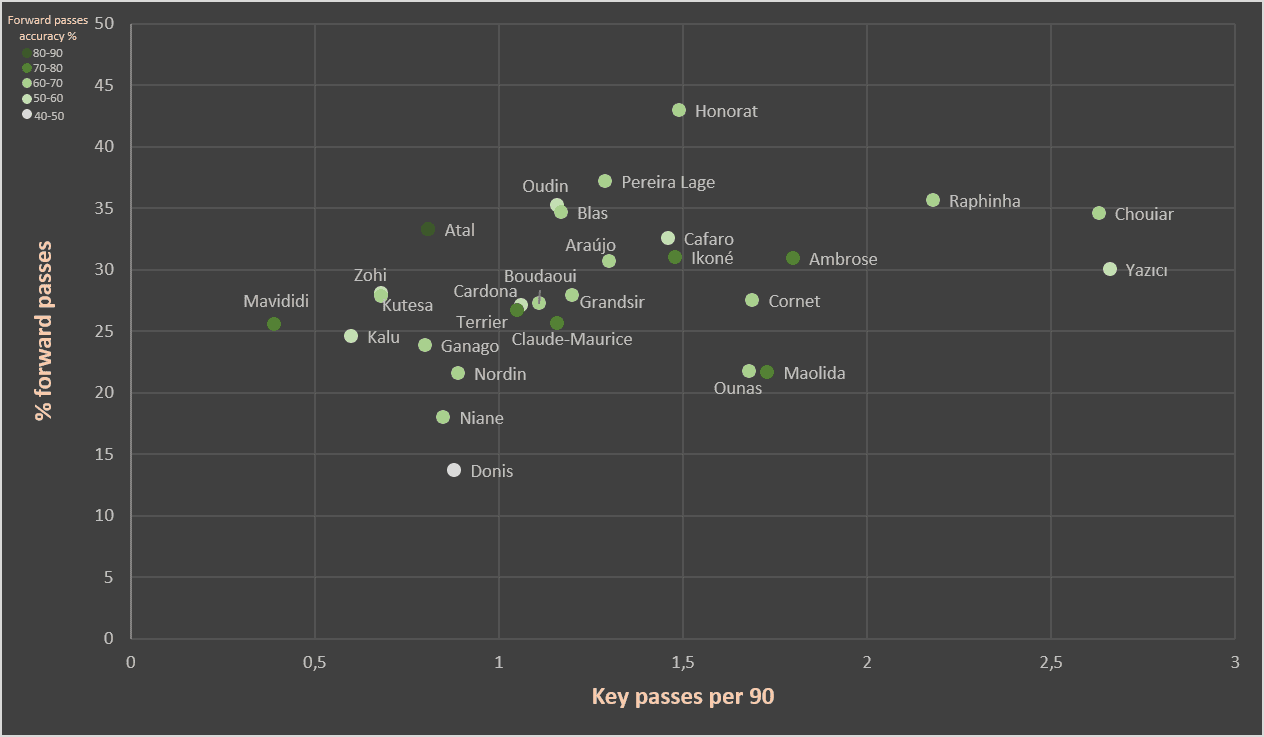
The former Lens player Mounir Chouiar, in addition to having a 35% forward pass rate, has the second-best total of key passes per 90 with 2.63. In addition to being devastating in his ability to dribble, Chouiar is also a player who is forward-looking, being able to create real scoring opportunities for his partners.
Yazıcı stands out once again in his ability to be creative with the ball. He plays 30% of his balls forward and has the best total of key passes per 90 with 2.66 per 90. Note that it is much more complex for a winger than for a player placed lower on the field to find solutions forward, as they have less space and time to act.
Raphinha also shows his qualities with 36% of forward passes and an interesting number of key passes per 90 with 2.18. The former Sporting CP winger had a very good season with Rennes, although it was his first season in France.
Offensive contribution
A creative player needs to be able to pass, but also be able to finish. This will make him all the more interesting, as he can be dangerous in any position. To analyse the players’ ability to perform well in the offensive contribution, we will judge their expected goals and their expected assists. The legend in the top left-hand corner shows the number of minutes played by the wingers, thus putting the numbers into context.
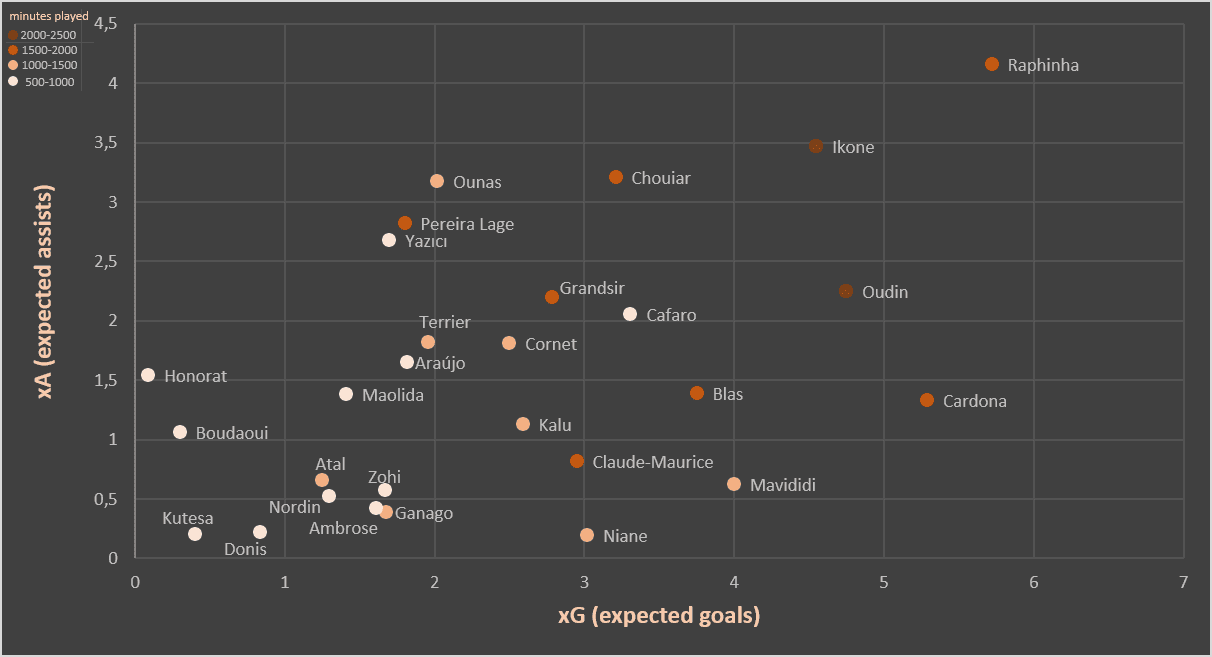
As can be seen in the graph above, Raphinha is well ahead, being the best performer in terms of xG (5.72) and xA (4.16). With five goals and three assists this season, the Rennes player has played a major role in his club’s very good season (Rennes finished third in Ligue 1). He will notably be taking part in the UEFA Champions League next season.
Chouiar and Ikoné are once again well placed in the ranking, particularly in their performance in terms of xA (3.21 xA for Chouiar and 3.47 for Ikoné). The latter has been very prolific this season at Lille, with three goals and six assists. Ounas is also one of the best performers on the graph in terms of xA with 3.17.
Cardona, whose profile is more that of a striker, is the second-best in terms of xG, with 5.29 (6 goals scored). He is logically very good in terms of finishing and is one of the revelations of the Ligue 1.
Forward runs
We judged the players on their ability to create action with their passes. But to be a creative winger, you have to be complete and also be able to move the ball forward through running, adding uncertainty for the opponent with dribbling. Dribbling is the essence of creativity, as there are a thousand and one ways to eliminate one or more opponents. Neymar’s creativity in dribbling is difficult to quantify for example, but the statistics of successful dribbles by 90 can be used.
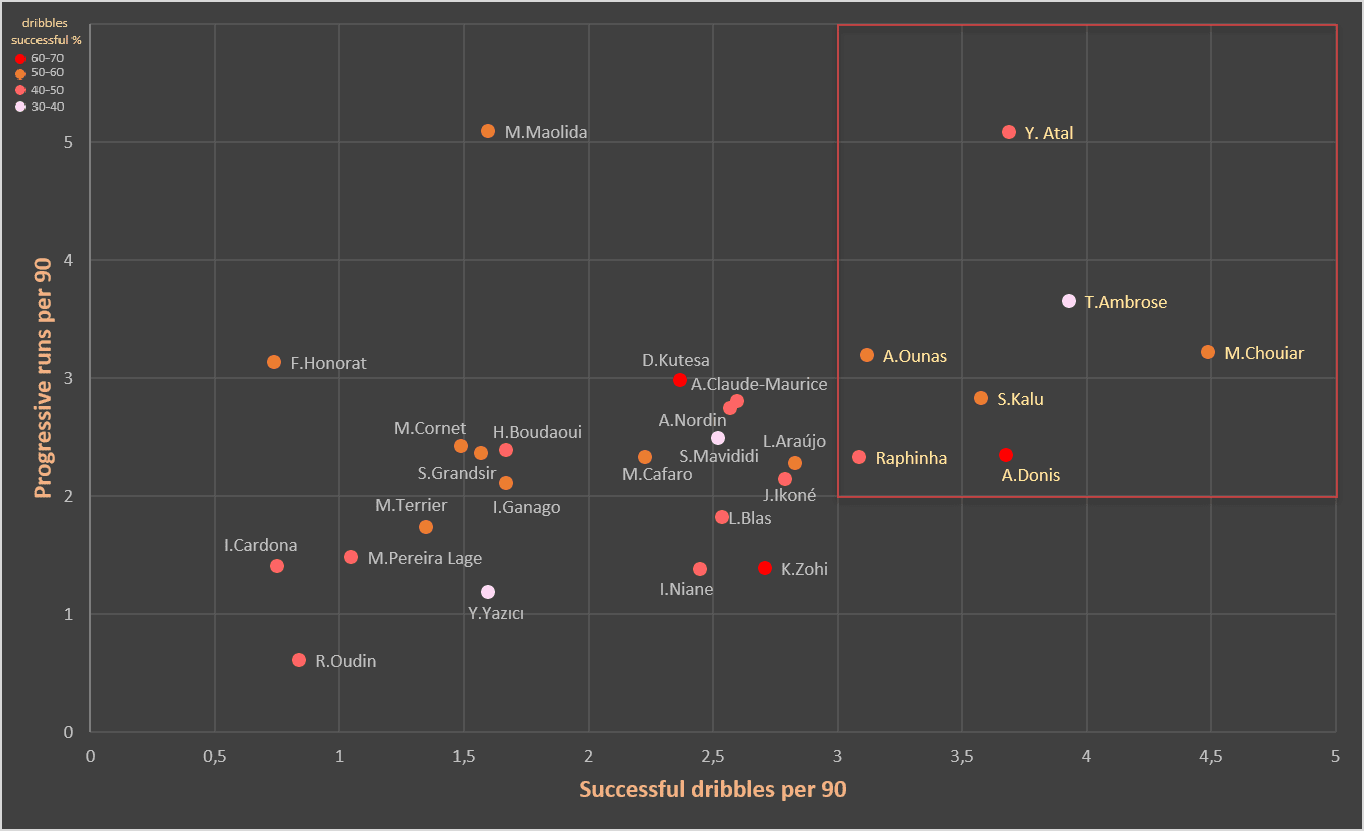
In the graph above, players are judged on their ability to run towards the opponent’s goal (progressive runs per 90), and their ability to eliminate their opponent (successful dribbles per 90).
Chouiar is an excellent dribbler with 4.49 successful dribbles per 90 and good stats in progressive runs (3.22 per 90). He has a very interesting rate of successful dribbles with 53.96%. The Dijon player was excellent for his first season in Ligue 1, especially in his ease with the ball at his feet and his fast direction shifts. We regularly see the young winger nearly full stop and then making a sudden acceleration. His short-dribbling skills allow him to be very good in tight spaces.
Thierry Ambrose (Metz) is also very good in this area with 3.93 successful dribbles per 90 and 3.65 progressive runs per 90. This is also the case for Anastasios Donis (3.68 successful dribbles) and Samuel Kalu (3.58).
The Brazilian Raphinha and Ounas are very close in terms of successful dribbles per 90 (3.09 and 3.12), but the Algerian player was better in terms of progressive runs per 90 (2.33 versus 3.19). Both players have a very good technique and are elegant in the way they dribble.
Shortlist
After this data analysis, we can highlight four very interesting profiles in the creativity they bring to their team. We will now take an overview to establish their profiles and compare them with each other. The following graph shows the statistics previously used to judge the creativity of the young wingers.
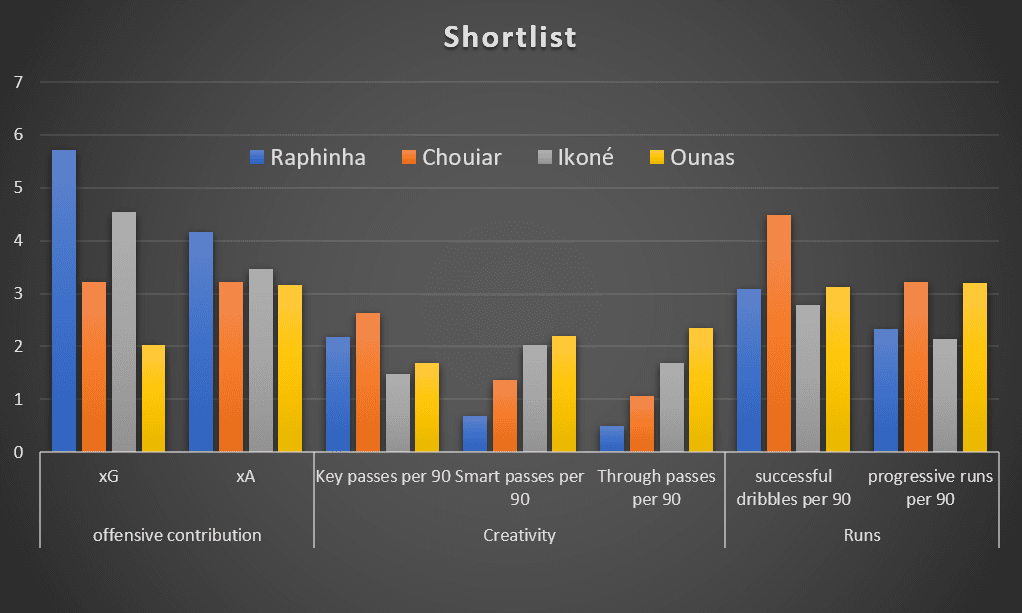
At just 21 years of age and in his first season in Ligue 1, Chouiar has shown some great things. As one of the best dribblers in Ligue 1, the former Lens player was one of the revelations of the season. Excellent in his ability to progress the game forward by running, he is also the best performer in the shortlist in terms of key passes per 90. Definitely a player to watch next season. Despite interesting xG and xA statistics, the Dijon player scored four goals but made no assists.
Raphinha is quite clearly above the others in terms of offensive contribution. The Rennes winger has scored five goals and made three assists this season. In particular, the former Sporting player has been able to bring the creative touch that Rennes lacked in attack. His market value on Transfermarkt has doubled this season from 8 to 16 million euros. He will have the opportunity to showcase his talent to the whole of Europe next season in the UEFA Champions League.
Ounas is the versatile profile of this shortlist. The player who was on loan from Napoli has shown real qualities in penetrating the opposition block, whether by passing or driving the ball. However, the 23-year-old Algerian made little offensive contribution compared to the other three players (xG and xA). He still has two goals and four assists.
The former PSG player Ikoné confirmed his good first season with Lille and was once again an important player in the northern team. He has played in a more axial role this season, as an advanced midfielder, but has also been seen playing on the wing. The 22-year-old shines less for his running and dribbling than for his creative passing. That’s because of the less space he has when playing in the middle. His attacking contribution remains very interesting with three goals and six assists.
Conclusion
This data analysis allowed us to highlight the most creative and complete young wingers in Ligue 1. The shortlist is made up of four players, but there are others who could also have been eligible. The French league is full of very talented players and looking at the creative side of these players allows us to identify and highlight those who have something extra.





Comments